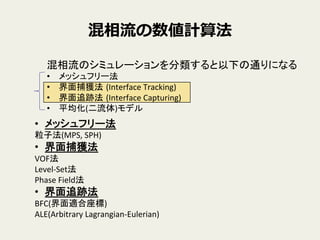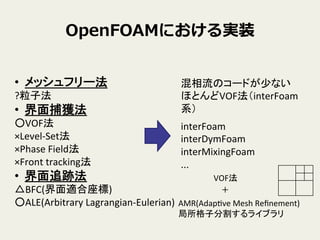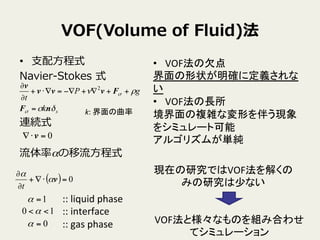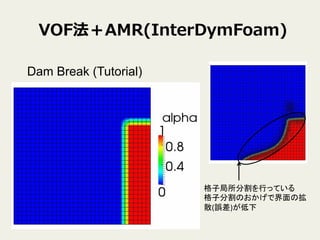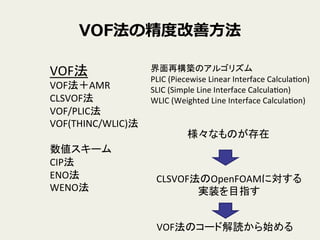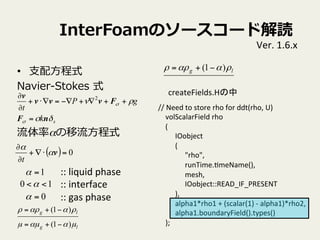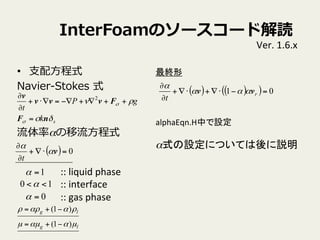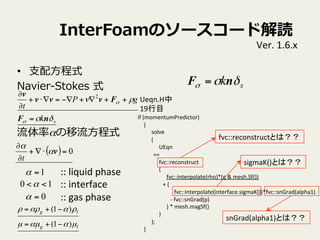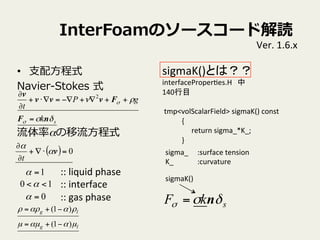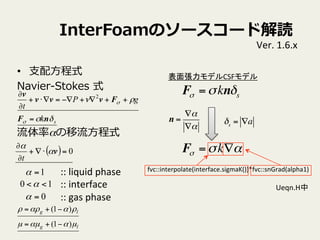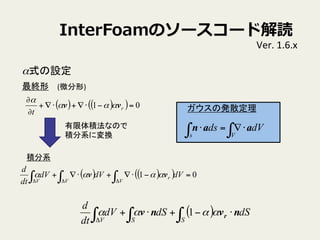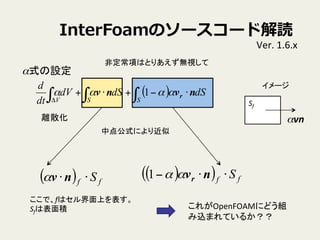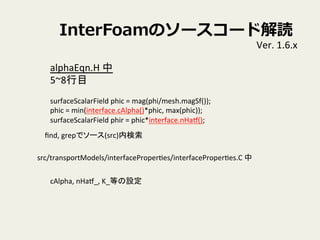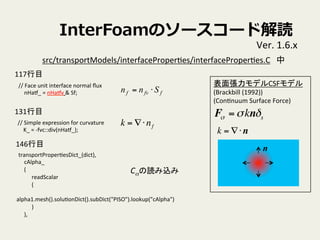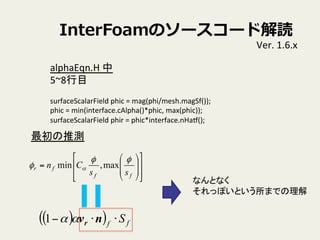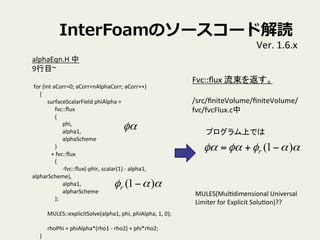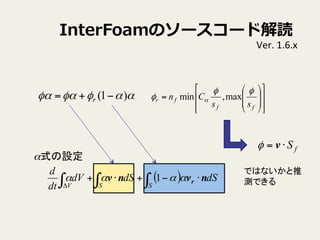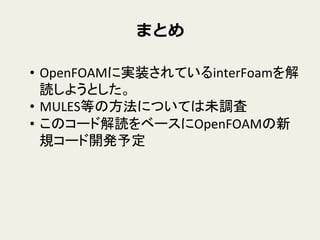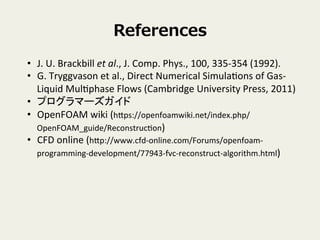翱辫别苍贵翱础惭における混相流计算
- 2. 混相流流とは 混相流???複数の相が混ざり合う流れ ? 例)気液二相流(空気-?‐水) ?キャビテーション、気泡塔 ? 液液二相流(水-?‐油) ? 有機溶媒と水の混合溶液 ? 固液二相流(粒子-?‐水) ?懸濁液 ? ? 工業的に重要であることが多い ? 様々な数値計算法が存在する
- 3. 混相流流の数値計算法 混相流のシミュレーションを分類すると以下の通りになる ? ?? メッシュフリー法 ? ?? 界面捕獲法 (Interface ?Tracking) ? ?? 界面追跡法 (Interface ?Capturing) ? ?? 平均化(二流体)モデル ? ?? メッシュフリー法 ? 粒子法(MPS, ?SPH) ? ?? 界面捕獲法 ? VOF法 ? Level-?‐Set法 ? Phase ?Field法 ? ?? 界面追跡法 ? BFC(界面適合座標) ? ALE(Arbitrary ?Lagrangian-?‐Eulerian) ?
- 4. それぞれの?手法の特徴 ?? メッシュフリー法 ? 微小の粒子の運動で表現する ? メッシュ分割が不必要 ? 衝撃波等の不連続場の扱いが容易 ? 大変形、歪みに対して精度保持 ? 精度が悪い ? 計算時間多大 ? ?? 界面捕獲法 ? 計算格子を移動せずに計算する ? 手法によって異なるが界面がなまる ? ?? 界面追跡法 ? 計算格子を時々刻々と移動する ? 精度がかなり高い ? 計算が破綻しやすい ? 砕波現象等の大変形をするものに不向き ? 概念図
- 5. OpenFOAMにおける実装 ?? メッシュフリー法 ? ?粒子法 ? ?? 界面捕獲法 ? ○VOF法 ? ×Level-?‐Set法 ? ×Phase ?Field法 ? ×Front ?tracking法 ? ?? 界面追跡法 ? △BFC(界面適合座標) ? ○ALE(Arbitrary ?Lagrangian-?‐Eulerian) ? 混相流のコードが少ない ? ほとんどVOF法(interFoam 系) interFoam ? interDymFoam ? interMixingFoam ? ... AMR(AdapVve ?Mesh ?Re?nement) ? 局所格子分割するライブラリ VOF法 +
- 6. VOF(Volume ?of ?Fluid)法 ?? ?支配?方程式 Navier-‐??Stokes ?式 連続式 流流体率率率αの移流流?方程式 sk gP t δσ ρν σ σ nF Fvvv v = ++?+??=??+ ? ? 2 0=?? v ?? VOF法の欠点 ? 界面の形状が明確に定義されな い ? ?? VOF法の長所 ? 境界面の複雑な変形を伴う現象 をシミュレート可能 ? アルゴリズムが単純 ? 現在の研究ではVOF法を解くの みの研究は少ない VOF法と様々なものを組み合わせ てシミュレーション k: ?界面の曲率 :: ?liquid ?phase ? :: ?interface ? :: ?gas ?phase 1=α 0=α 10 <<α ( ) 0=??+ ? ? vα α t
- 7. VOF法の精度度改善?方法 VOF法 ? VOF法+AMR ? CLSVOF法 ? VOF/PLIC法 ? VOF/SLIC法 ? VOF/WLIC法 ? VOF/IB法 ? ? 数値スキーム ? CIP法 ? WENO法 界面再構築のアルゴリズム ? PLIC ?(Piecewise ?Linear ?Interface ?CalculaVon) ? SLIC ?(Simple ?Line ?Interface ?CalculaVon) ? WLIC ?(Weighted ?Line ?Interface ?CalculaVon) 様々なものが存在 洋書 ? 2011年出版(初版) ? Cambridge ?Univ. ?Press ? 混相流の計算手法について ? (主にVOF系, ?Front-?‐Tracking, ? Level-?‐Set ?など) ?
- 8. VOF法(InterFoam) Dam Break (Tutorial) 界面の拡散(誤差) ? VOF法のみでは誤差が大きい
- 9. VOF法+AMR(InterDymFoam) Dam Break (Tutorial) 格子局所分割を行っている ? 格子分割のおかげで界面の拡 散(誤差)が低下
- 10. VOF法の精度度改善?方法 VOF法 ? VOF法+AMR ? CLSVOF法 ? VOF/PLIC法 ? VOF(THINC/WLIC)法 ? ? 数値スキーム ? CIP法 ? ENO法 ? WENO法 界面再構築のアルゴリズム ? PLIC ?(Piecewise ?Linear ?Interface ?CalculaVon) ? SLIC ?(Simple ?Line ?Interface ?CalculaVon) ? WLIC ?(Weighted ?Line ?Interface ?CalculaVon) 様々なものが存在 CLSVOF法のOpenFOAMに対する 実装を目指す VOF法のコード解読から始める
- 11. // ?Need ?to ?store ?rho ?for ?ddt(rho, ?U) volScalarField ?rho ( IOobject ( "rho", runTime.VmeName(), mesh, IOobject::READ_IF_PRESENT ), alpha1*rho1 ?+ ?(scalar(1) ?-?‐ ?alpha1)*rho2, alpha1.boundaryField().types() ); InterFoamのソースコード解読 ?? ?支配?方程式 Navier-‐??Stokes ?式 流流体率率率αの移流流?方程式 sk gP t δσ ρν σ σ nF Fvvv v = ++?+??=??+ ? ? 2 :: ?liquid ?phase ? :: ?interface ? :: ?gas ?phase 1=α 0=α 10 <<α lg lg ?αα?? ρααρρ )1( )1( ?+= ?+= lg ρααρρ )1( ?+= createFields.Hの中 Ver. ?1.6.x ( ) 0=??+ ? ? vα α t
- 12. InterFoamのソースコード解読 ?? ?支配?方程式 Navier-‐??Stokes ?式 流流体率率率αの移流流?方程式 sk gP t δσ ρν σ σ nF Fvvv v = ++?+??=??+ ? ? 2 :: ?liquid ?phase ? :: ?interface ? :: ?gas ?phase 1=α 0=α 10 <<α lg lg ?αα?? ρααρρ )1( )1( ?+= ?+= Ver. ?1.6.x lg ?αα?? )1( ?+= /src/transportModels/incompressible/ ? incompressibleTwoPhaseMixture/ ? twoPhaseMixture.C ? 118行目 ? ? tmp<volScalarField> ?twoPhaseMixture::mu() ?const { volScalarField ?limitedAlpha1 ?= ?min(max(alpha1_, ?scalar(0)), ?scalar(1)); return ?tmp<volScalarField> ( new ?volScalarField ( "mu", limitedAlpha1*rho1_*nuModel1_-?‐>nu() + ?(scalar(1) ?-?‐ ?limitedAlpha1)*rho2_*nuModel2_-?‐>nu() ) ); } ( ) 0=??+ ? ? vα α t
- 13. InterFoamのソースコード解読 ?? ?支配?方程式 Navier-‐??Stokes ?式 流流体率率率αの移流流?方程式 sk gP t δσ ρν σ σ nF Fvvv v = ++?+??=??+ ? ? 2 :: ?liquid ?phase ? :: ?interface ? :: ?gas ?phase 1=α 0=α 10 <<α Ver. ?1.6.x ( ) 0=??+ ? ? vα α t 液相領域 ? ? 気相領域 ( ) 0=??+ ? ? l t vα α ( ) 0=??+ ? ? vα α t ( )( ) 01 =???+ ? ? g t vα α 小文字l, ?gはそれぞれ液相、気相を表す。 ( ) glr gl vvv vvv ?= ?+= αα 1 vr: ?相関速度 再定義 lg lg ?αα?? ρααρρ )1( )1( ?+= ?+=
- 14. InterFoamのソースコード解読 ?? ?支配?方程式 Navier-‐??Stokes ?式 流流体率率率αの移流流?方程式 sk gP t δσ ρν σ σ nF Fvvv v = ++?+??=??+ ? ? 2 :: ?liquid ?phase ? :: ?interface ? :: ?gas ?phase 1=α 0=α 10 <<α Ver. ?1.6.x ( ) ( )( ) 01 =???+??+ ? ? r t vv ααα α 最終形 alphaEqn.H中で設定 ? ? α式の設定については後に説明 ( ) 0=??+ ? ? vα α t lg lg ?αα?? ρααρρ )1( )1( ?+= ?+=
- 15. InterFoamのソースコード解読 ?? ?支配?方程式 Navier-‐??Stokes ?式 流流体率率率αの移流流?方程式 sk gP t δσ ρν σ σ nF Fvvv v = ++?+??=??+ ? ? 2 :: ?liquid ?phase ? :: ?interface ? :: ?gas ?phase 1=α 0=α 10 <<α Ver. ?1.6.x 表面張力モデルCSFモデル ? (Brackbill ?(1992)) ? (ConVnuum ?Surface ?Force) sk δσσ nF = σ: ?表面張力 ? k: ?曲率 ? n: ?法線ベクトル ? δs: ?δ関数 表面張力 ? 面積力 ?体積力 ? (面にかかる力) ? ?(体積にかかる力) ( ) 0=??+ ? ? vα α t lg lg ?αα?? ρααρρ )1( )1( ?+= ?+=
- 16. ? ?Ueqn.H中 ? ? ?19行目 ? ?if ?(momentumPredictor) { solve ( UEqn == fvc::reconstruct ( fvc::interpolate(rho)*(g ?& ?mesh.Sf()) + ?( fvc::interpolate(interface.sigmaK())*fvc::snGrad(alpha1) -?‐ ?fvc::snGrad(p) ) ?* ?mesh.magSf() ) ); } InterFoamのソースコード解読 ?? ?支配?方程式 Navier-‐??Stokes ?式 流流体率率率αの移流流?方程式 :: ?liquid ?phase ? :: ?interface ? :: ?gas ?phase 1=α 0=α 10 <<α Ver. ?1.6.x sk δσσ nF = sk gP t δσ ρν σ σ nF Fvvv v = ++?+??=??+ ? ? 2 ( ) 0=??+ ? ? vα α t lg lg ?αα?? ρααρρ )1( )1( ?+= ?+= sigmaK()とは?? snGrad(alpha1)とは?? fvc::reconstructとは??
- 17. InterFoamのソースコード解読 ?? ?支配?方程式 Navier-‐??Stokes ?式 流流体率率率αの移流流?方程式 :: ?liquid ?phase ? :: ?interface ? :: ?gas ?phase 1=α 0=α 10 <<α Ver. ?1.6.x ( ) 0=??+ ? ? vα α t lg lg ?αα?? ρααρρ )1( )1( ?+= ?+= sigmaK()とは?? ? interfaceProperVes.H 中 ? 140行目 ? ? ?tmp<volScalarField> ?sigmaK() ?const { return ?sigma_*K_; } sigma_ ?:surface ?tension ? K_ ?:curvature sigmaK() skF δσσ n= sk gP t δσ ρν σ σ nF Fvvv v = ++?+??=??+ ? ? 2
- 18. InterFoamのソースコード解読 ?? ?支配?方程式 Navier-‐??Stokes ?式 流流体率率率αの移流流?方程式 :: ?liquid ?phase ? :: ?interface ? :: ?gas ?phase 1=α 0=α 10 <<α Ver. ?1.6.x ( ) 0=??+ ? ? vα α t lg lg ?αα?? ρααρρ )1( )1( ?+= ?+= snGrad(alpha1)とは?? ? プログラマズガイドより ? 面に垂直なベクトル成分を表す。 α α ? ? =n α場(赤:流体,青:気体) α? sk gP t δσ ρν σ σ nF Fvvv v = ++?+??=??+ ? ? 2
- 19. InterFoamのソースコード解読 ?? ?支配?方程式 Navier-‐??Stokes ?式 流流体率率率αの移流流?方程式 :: ?liquid ?phase ? :: ?interface ? :: ?gas ?phase 1=α 0=α 10 <<α Ver. ?1.6.x ( ) 0=??+ ? ? vα α t lg lg ?αα?? ρααρρ )1( )1( ?+= ?+= sk gP t δσ ρν σ σ nF Fvvv v = ++?+??=??+ ? ? 2 fvc::interpolate(interface.sigmaK())*fvc::snGrad(alpha1) Fσ =σknδs 表面張力モデルCSFモデル ? n = ?α ?α δs = ?a Fσ =σk?α ?Ueqn.H中
- 20. fvc::reconstructとは?? ? OpenFOAM ?wiki ?+ ?CFD ?onlineより ? InterFoamのソースコード解読 ?? ?支配?方程式 Navier-‐??Stokes ?式 流流体率率率αの移流流?方程式 :: ?liquid ?phase ? :: ?interface ? :: ?gas ?phase 1=α 0=α 10 <<α Ver. ?1.6.x ( ) 0=??+ ? ? vα α t lg lg ?αα?? ρααρρ )1( )1( ?+= ?+= sk gP t δσ ρν σ σ nF Fvvv v = ++?+??=??+ ? ? 2 hpp://www.cfd-?‐online.com/Forums/openfoam-?‐programming-?‐ development/77943-?‐fvc-?‐reconstruct-?‐algorithm.html hpps://openfoamwiki.net/index.php/OpenFOAM_guide/ ReconstrucVon セル界面でのFluxからセル中心での速度 ベクトルを返す。 output ?= ?fvc::reconstruct(input) output ?:: ?セル中心での速度ベクトル ? input ?:: ?セル界面でのFlux 目的: ?圧力振動を生じさせないように、擬 似的なスタッガード格子のように作用させ るため。
- 21. InterFoamのソースコード解読 Ver. ?1.6.x α式の設定 ( ) ( )( ) 01 =???+??+ ? ? r t vv ααα α 最終形 (微分形) 有限体積法なので ? 積分系に変換 積分系 ( ) ( )( ) 01 =???+??+ ∫∫∫ ΔΔΔ dVdVdV dt d V r VV vv αααα ガウスの発散定理 dVds Vs ∫∫ ??=? aan ( ) dSdSdV dt d SSV ∫∫∫ ??+?+ Δ nvnv rαααα 1
- 22. InterFoamのソースコード解読 Ver. ?1.6.x α式の設定 ( ) dSdSdV dt d SSV ∫∫∫ ??+?+ Δ nvnv rαααα 1 離散化 非定常項はとりあえず無視して ( )( ) ff S??? nvrαα1( ) ff S??nvα ここで、fはセル界面上を表す。 ? Sfは表面積 中点公式により近似 Sf αvn イメージ これがOpenFOAMにどう組 み込まれているか??
- 23. InterFoamのソースコード解読 Ver. ?1.6.x alphaEqn.H ?中 ? 5~8行目 ? ? surfaceScalarField ?phic ?= ?mag(phi/mesh.magSf()); phic ?= ?min(interface.cAlpha()*phic, ?max(phic)); surfaceScalarField ?phir ?= ?phic*interface.nHat(); ? f c S φ φ = ))max(,min( ccc C φφφ α ×= fcr n×=φφ それぞれ 代入 ?? ?? ?? ?? ?? ?? ?? ?? ?? ?? ?? ?? ?? ?? ?? ?? = ff fr ss Cn φφ φ α max,min プログラム上では ( )( ) ff S??? nvrαα1 文字rから判断すると??
- 24. InterFoamのソースコード解読 Ver. ?1.6.x alphaEqn.H ?中 ? 5~8行目 ? ? surfaceScalarField ?phic ?= ?mag(phi/mesh.magSf()); phic ?= ?min(interface.cAlpha()*phic, ?max(phic)); surfaceScalarField ?phir ?= ?phic*interface.nHat(); ? ?nd, ?grepでソース(src)内検索 src/transportModels/interfaceProperVes/interfaceProperVes.C ?中 cAlpha, ?nHat_, ?K_等の設定
- 25. InterFoamのソースコード解読 Ver. ?1.6.x // ?Face ?unit ?interface ?normal ??ux nHat_ ?= ?nHatv ?& ?Sf; // ?Simple ?expression ?for ?curvature K_ ?= ?-?‐fvc::div(nHat_); transportProperVesDict_(dict), cAlpha_ ( readScalar ( alpha1.mesh().soluVonDict().subDict("PISO").lookup("cAlpha") ) ), src/transportModels/interfaceProperVes/interfaceProperVes.C 中 ffvf Snn ?= 表面張力モデルCSFモデル ? (Brackbill ?(1992)) ? (ConVnuum ?Surface ?Force) Fσ =σknδs k = ??nf k = ??n n Cαの読み込み 131行目 117行目 146行目
- 26. InterFoamのソースコード解読 Ver. ?1.6.x // ?Face ?unit ?interface ?normal surfaceVectorField ?nHatv ?= ?gradAlphaf/ (mag(gradAlphaf) ?+ ?deltaN_); src/transportModels/interfaceProperVes/interfaceProperVes.C 中 113行目 nfv = ?α( )f ?α( )f +δN deltaN_ ( "deltaN", 1e-?‐8/pow(average(alpha1.mesh().V()), ?1.0/3.0) ), 156行目 δN = 1.0×10?8 ( Vi / N N ∑ )1/3 界面の法線方向計算の安定化 ? (ゼロ割を防ぐ)
- 27. InterFoamのソースコード解読 Ver. ?1.6.x alphaEqn.H ?中 ? 5~8行目 ? ? surfaceScalarField ?phic ?= ?mag(phi/mesh.magSf()); phic ?= ?min(interface.cAlpha()*phic, ?max(phic)); surfaceScalarField ?phir ?= ?phic*interface.nHat(); ? ?? ?? ?? ?? ?? ?? ?? ?? ?? ?? ?? ?? ?? ?? ?? ?? = ff fr ss Cn φφ φ α max,min ( )( ) ff S??? nvrαα1 最初の推測 なんとなく ? それっぽいという所までの理解
- 28. InterFoamのソースコード解読 Ver. ?1.6.x alphaEqn.H ?中 ? 9行目~ ? ? ?for ?(int ?aCorr=0; ?aCorr<nAlphaCorr; ?aCorr++) { surfaceScalarField ?phiAlpha ?= fvc::?ux ( phi, alpha1, alphaScheme ) + ?fvc::?ux ( -?‐fvc::?ux(-?‐phir, ?scalar(1) ?-?‐ ?alpha1, ? alpharScheme), alpha1, alpharScheme ); MULES::explicitSolve(alpha1, ?phi, ?phiAlpha, ?1, ?0); rhoPhi ?= ?phiAlpha*(rho1 ?-?‐ ?rho2) ?+ ?phi*rho2; } ? Fvc::?ux ?流束を返す。 ? ? /src/?niteVolume/?niteVolume/ fvc/fvcFlux.c中 φα ααφ )1( ?r ααφφαφα )1( ?+= r プログラム上では MULES(MulVdimensional ?Universal ? Limiter ?for ?Explicit ?SoluVon)??
- 29. InterFoamのソースコード解読 Ver. ?1.6.x ?? ?? ?? ?? ?? ?? ?? ?? ?? ?? ?? ?? ?? ?? ?? ?? = ff fr ss Cn φφ φ α max,minααφφαφα )1( ?+= r α式の設定 ( ) dSdSdV dt d SSV ∫∫∫ ??+?+ Δ nvnv rαααα 1 fS?= vφ ではないかと推 測できる
- 30. ( )( ) ff S??? nvrαα1 ?? ?? ?? ?? ?? ?? ?? ?? ?? ?? ?? ?? ?? ?? ?? ?? ?? f ff f ff f S Su S Su Cn max,min α OpenFOAMのコード内 nfv = ?α( )f ?α( )f +δN δN = 1.0×10?8 ( Vi / N N ∑ )1/3 解を安定化するもの ? (nfvが無限大になるのを防ぐ) 人工的に界面幅を圧縮する項 ffvf Snn ?= α場(赤:流体, 青:気体) α? InterFoamのソースコード解読
- 31. まとめ ?? OpenFOAMに実装されているinterFoamを解 読しようとした。 ? ?? MULES等の方法については未調査 ? ?? このコード解読をベースにOpenFOAMの新 規コード開発予定
- 32. References ?? J. ?U. ?Brackbill ?et ?al., ?J. ?Comp. ?Phys., ?100, ?335-?‐354 ?(1992). ? ?? G. ?Tryggvason ?et ?al., ?Direct ?Numerical ?SimulaVons ?of ?Gas-?‐ Liquid ?MulVphase ?Flows ?(Cambridge ?University ?Press, ?2011) ? ?? プログラマーズガイド ? ?? OpenFOAM ?wiki ?(hpps://openfoamwiki.net/index.php/ OpenFOAM_guide/ReconstrucVon) ? ?? CFD ?online ?(hpp://www.cfd-?‐online.com/Forums/openfoam-?‐ programming-?‐development/77943-?‐fvc-?‐reconstruct-?‐algorithm.html)


